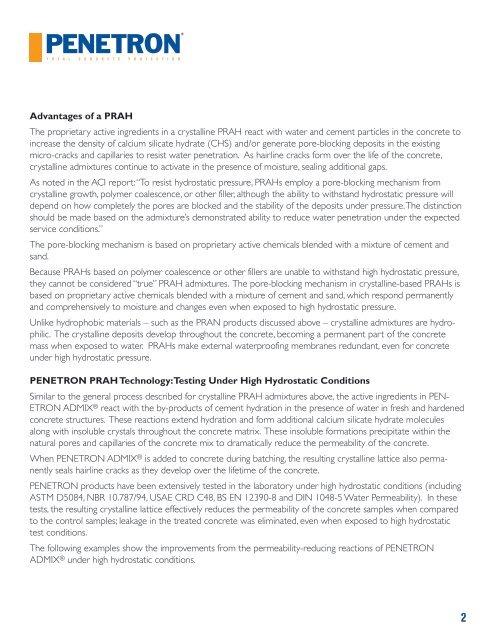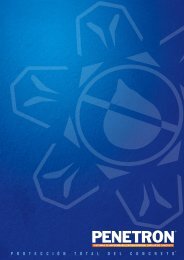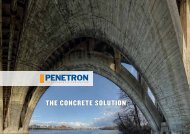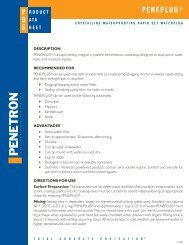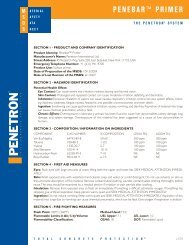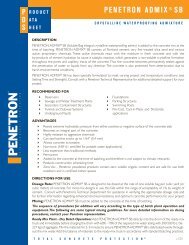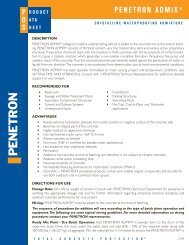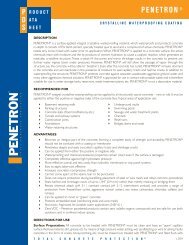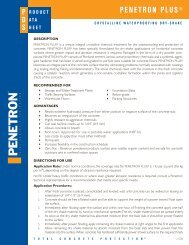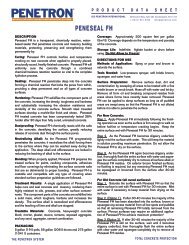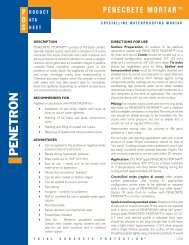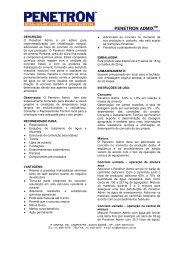PRAN vs. PRAH: THE PENETRON DIFFERENCE
PRAN vs. PRAH: THE PENETRON DIFFERENCE
PRAN vs. PRAH: THE PENETRON DIFFERENCE
Create successful ePaper yourself
Turn your PDF publications into a flip-book with our unique Google optimized e-Paper software.
®T O T A L C O N C R E T E P R O T E C T I O NAdvantages of a <strong>PRAH</strong>The proprietary active ingredients in a crystalline <strong>PRAH</strong> react with water and cement particles in the concrete toincrease the density of calcium silicate hydrate (CHS) and/or generate pore-blocking deposits in the existingmicro-cracks and capillaries to resist water penetration. As hairline cracks form over the life of the concrete,crystalline admixtures continue to activate in the presence of moisture, sealing additional gaps.As noted in the ACI report: “To resist hydrostatic pressure, <strong>PRAH</strong>s employ a pore-blocking mechanism fromcrystalline growth, polymer coalescence, or other filler, although the ability to withstand hydrostatic pressure willdepend on how completely the pores are blocked and the stability of the deposits under pressure. The distinctionshould be made based on the admixture’s demonstrated ability to reduce water penetration under the expectedservice conditions.”The pore-blocking mechanism is based on proprietary active chemicals blended with a mixture of cement andsand.Because <strong>PRAH</strong>s based on polymer coalescence or other fillers are unable to withstand high hydrostatic pressure,they cannot be considered “true” <strong>PRAH</strong> admixtures. The pore-blocking mechanism in crystalline-based <strong>PRAH</strong>s isbased on proprietary active chemicals blended with a mixture of cement and sand, which respond permanentlyand comprehensively to moisture and changes even when exposed to high hydrostatic pressure.Unlike hydrophobic materials – such as the <strong>PRAN</strong> products discussed above – crystalline admixtures are hydrophilic.The crystalline deposits develop throughout the concrete, becoming a permanent part of the concretemass when exposed to water. <strong>PRAH</strong>s make external waterproofing membranes redundant, even for concreteunder high hydrostatic pressure.<strong>PENETRON</strong> <strong>PRAH</strong> Technology: Testing Under High Hydrostatic ConditionsSimilar to the general process described for crystalline <strong>PRAH</strong> admixtures above, the active ingredients in PEN-ETRON ADMIX ® react with the by-products of cement hydration in the presence of water in fresh and hardenedconcrete structures. These reactions extend hydration and form additional calcium silicate hydrate moleculesalong with insoluble crystals throughout the concrete matrix. These insoluble formations precipitate within thenatural pores and capillaries of the concrete mix to dramatically reduce the permeability of the concrete.When <strong>PENETRON</strong> ADMIX ® is added to concrete during batching, the resulting crystalline lattice also permanentlyseals hairline cracks as they develop over the lifetime of the concrete.<strong>PENETRON</strong> products have been extensively tested in the laboratory under high hydrostatic conditions (includingASTM D5084, NBR 10.787/94, USAE CRD C48, BS EN 12390-8 and DIN 1048-5 Water Permeability). In thesetests, the resulting crystalline lattice effectively reduces the permeability of the concrete samples when comparedto the control samples; leakage in the treated concrete was eliminated, even when exposed to high hydrostatictest conditions.The following examples show the improvements from the permeability-reducing reactions of <strong>PENETRON</strong>ADMIX ® under high hydrostatic conditions.2


